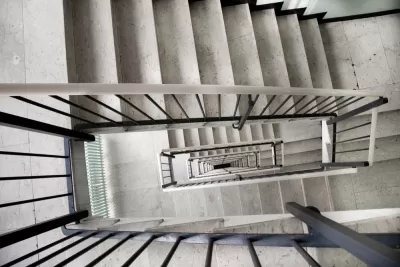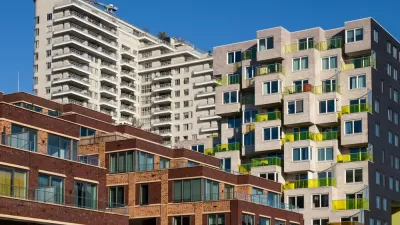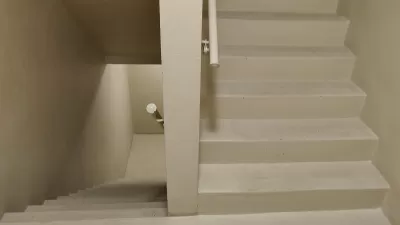Critics of the double-staircase mandate for multi-story buildings argue that it does little to improve fire safety while raising the costs of housing construction and limiting community interaction.

“If a rule to allow new construction to have a single staircase up to six stories is approved, then smaller buildings that better foster community among residents could begin popping up in cities and towns across the commonwealth [of Virginia],” reports Wyatt Gordon for The Virginia Mercury. “Although the United States and Canada lowered the height limit for such construction to three stories nearly a century ago, the rest of the world never allowed fears of fires to hinder such housing.” In fact, many of Virginia’s older buildings were constructed before the double-staircase rule was put into place.
“Modern American building codes mandate double-loaded staircases if a building exceeds three stories, inevitably leading developers to build the big, bland 5-over-1s” and forcing buildings to take up more real estate. “Efforts to present fire experts with the facts on single staircase structures are already underway giving advocates hope that fire officials’ support can be secured before DHCD comes to a final decision later this year,” notes Gordon.
Proponents of single-staircase buildings point to several advantages. “Instead of the long, dark corridors demanded by double-loaded staircases, single staircase buildings create community through their compactness.” Additionally, “When there is no cavernous hallway going straight through the middle of the building apartments can stretch from one side of the building to the other, enabling cross ventilation and sunlight on both sides of the unit.”
Like parking minimums and other building code requirements, the double-staircase mandate can have a powerful impact on housing affordability and construction costs. “Increased living space and lower construction costs translate to more affordable rents without any state subsidy required,” making it easier for private developers to build more affordable housing.
FULL STORY: How allowing single-staircase buildings could change Virginia’s housing market

Planetizen Federal Action Tracker
A weekly monitor of how Trump’s orders and actions are impacting planners and planning in America.

Congressman Proposes Bill to Rename DC Metro “Trump Train”
The Make Autorail Great Again Act would withhold federal funding to the system until the Washington Metropolitan Area Transit Authority (WMATA), rebrands as the Washington Metropolitan Authority for Greater Access (WMAGA).

DARTSpace Platform Streamlines Dallas TOD Application Process
The Dallas transit agency hopes a shorter permitting timeline will boost transit-oriented development around rail stations.

Renters Now Outnumber Homeowners in Over 200 US Suburbs
High housing costs in city centers and the new-found flexibility offered by remote work are pushing more renters to suburban areas.

The Tiny, Adorable $7,000 Car Turning Japan Onto EVs
The single seat Mibot charges from a regular plug in about as much time as an iPad, and is about half the price of an average EV.

Supreme Court Ruling in Pipeline Case Guts Federal Environmental Law
The decision limits the scope of a federal law that mandates extensive environmental impact reviews of energy, infrastructure, and transportation projects.
Urban Design for Planners 1: Software Tools
This six-course series explores essential urban design concepts using open source software and equips planners with the tools they need to participate fully in the urban design process.
Planning for Universal Design
Learn the tools for implementing Universal Design in planning regulations.
Roanoke Valley-Alleghany Regional Commission
City of Mt Shasta
City of Camden Redevelopment Agency
City of Astoria
Transportation Research & Education Center (TREC) at Portland State University
US High Speed Rail Association
City of Camden Redevelopment Agency
Municipality of Princeton (NJ)





























